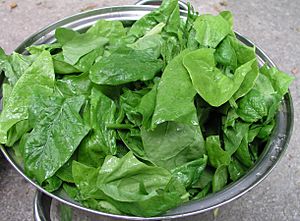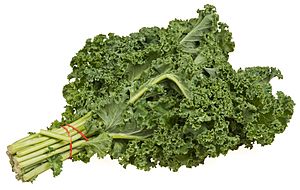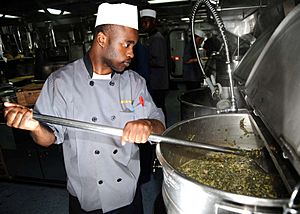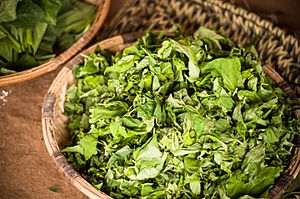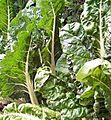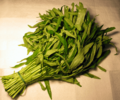Leaf vegetable facts for kids
Leaf vegetables, also known as leafy greens or just greens, are the leaves of plants that people eat as a vegetable. Sometimes, the soft stems (called petioles) and young shoots are also eaten. Even though these greens come from many different kinds of plants, they are often similar in what nutrients they offer and how they are cooked.
There are almost a thousand types of plants with edible leaves! Most leaf vegetables come from small, soft plants like lettuce and spinach. But some leaves from woody plants are also good to eat.
Even the leaves of many plants grown for animal food, like alfalfa or clover, can be eaten by humans. However, people usually only eat these if there isn't much other food available. These plants grow a lot, but their leaves have a lot of fiber, which makes them hard for humans to digest. To make them easier to eat, they can be dried, ground into powder, or juiced.
Leaf vegetables are packed with nutrients. Because they are the parts of the plant that do photosynthesis (making food from sunlight), they are especially high in vitamin K.
Contents
What's in Leafy Greens?
Leaf vegetables are usually low in calories and fat. They are high in protein for their calorie count, and they have lots of dietary fiber. They also give you plenty of vitamin C, vitamin A (from carotenoids), folate, manganese, and a lot of vitamin K.
The amount of vitamin K in leafy greens is very high because this vitamin helps plants with photosynthesis. If someone is taking certain medicines, like warfarin, they might need to be careful about how many leaf vegetables they eat. This is because vitamin K can affect how their medicine works.
How We Prepare Leafy Greens
Leaf vegetables can be cooked in many ways. They can be stir-fried, stewed, or steamed. When they are cooked, they are sometimes called "boiled greens." In the Southern United States, stewed leafy greens with pork are a traditional dish. They are also common in South Asian dishes like saag.
Many leafy greens, such as lettuce or spinach, can be eaten raw. You can find them in sandwiches or salads. A green smoothie is another way to eat a lot of raw leafy greens by blending them with fruit and water.
Leafy Greens Around the World
Leafy greens are enjoyed in different ways all over the world!
Africa
In some African countries, different types of amaranth are boiled and eaten often because they are very nutritious. Celosia argentea (sometimes called "Lagos spinach") is also a popular boiled green in West Africa.
Greece
In Greek cuisine, a dish called khorta (which means 'greens') is a common side dish. It can be eaten hot or cold and is usually seasoned with olive oil and lemon.
Greeks use at least 80 different kinds of greens, depending on the area and the time of year. Some examples include dandelion, chicory, kale, and even the fresh leaves of the caper plant.
Italy
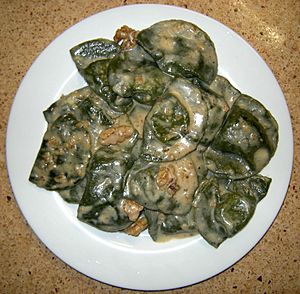
In the Ligurian cuisine of Italy, a mix of different wild boiled greens called preboggion is used to fill ravioli and pansoti. One important ingredient in preboggion is borage leaves. Preboggion is also sometimes added to minestrone soup and frittata.
Poland
Botwinka (or boćwinka) is a soup from Poland. Its main ingredients are the stems and leaves of beets. The word "botwinka" is a smaller version of "botwina," which means leafy vegetables like chard and beet leaves.
United States
In the cuisine of the Southern United States and African-American cuisine, greens like turnip, collard, kale, dandelion, and mustard are often cooked. They are usually served with pieces of ham or bacon. The water left over from boiling the greens, called potlikker, is used as a flavorful broth.
Sauteed escarole is a key ingredient in the Italian-American dish called Utica greens.
Types of Leaf Vegetables
- Agastache foeniculum — anise hyssop (western North America)
- Allium fistulosum — Welsh onion (East Asia)
- Alternanthera sissoo — sissoo spinach (Brazil)
- Basella alba — Malabar spinach(India, Southeast Asia, New Guinea)
- Beta vulgaris — beets, including beet greens, Swiss chard
- Brassica oleracea — wild cabbage, including cabbage, gai lan, Jersey cabbage, kale, red cabbage, savoy cabbage, collard greens, mustard greens, kohlrabi and more
- Brassica rapa — field mustard, including napa cabbage, bok choy, bomdong, choy sum, komatsuna, rapini, tatsoi, and more
- Campanula versicolor — various-colored bellflower (southeastern Italy to the Balkans)
- Chenopodium quinoa — quinoa (western Andes of South America)
- Cichorium endivia — endive, including escarole
- Cichorium intybus — chicory (Europe)
- Claytonia perfoliata — palsingat (western North America)
- Cnidoscolus aconitifolius — chaya (Yucatán Peninsula of Mexico)
- Daucus carota subsp. sativus — carrot (Europe and Southwestern Asia)
- Eruca vesicaria — arugula or rocket (Mediterranean region)
- Foeniculum vulgare — fennel (southern Europe)
- Gynura bicolor — edible gynura (China, Thailand, Myanmar)
- Gynura procumbens — longevity spinach (China, Southeast Asia, and Africa)
- Hemerocallis fulva — orange day-lily (China or Japan)
- Lepidium meyenii — maca (Andes)
- Lactuca sativa — lettuce, including celtuce, iceberg lettuce, red leaf lettuce, romaine lettuce
- Nasturtium officinale — watercress (Europe and Asia)
- Malva moschata — musk mallow (Europe and southwestern Asia)
- Moringa oleifera — moringa (Indian subcontinent)
- Perilla frutescens — shisho perilla (Southeast Asia and Indian highlands)
- Rumex acetosa — garden sorrel (most of Europe, temperate Asia, North America, and Greenland)
- Sassafras albidum — sassafras (eastern North America)
- Sauropus androgynus — katuk (South Asia and Southeast Asia)
- Spinacia oleracea — spinach (central and western Asia)
- Solanum aethiopicum — nakati (Asia and tropical Africa)
- Tropaeolum majus — garden nasturtium (Andes)
- Viola odorata — sweet violet (Europe, northern Africa, Syria)
- Trigonella foenum-graecum - Fenugreek (India)
Images for kids
-
Gotukola (Centella asiatica)
-
Sabzi Khordan, an Iranian salad-like dish, here of mixed greens and radishes
See also
 In Spanish: Verdura de hoja para niños
In Spanish: Verdura de hoja para niños


